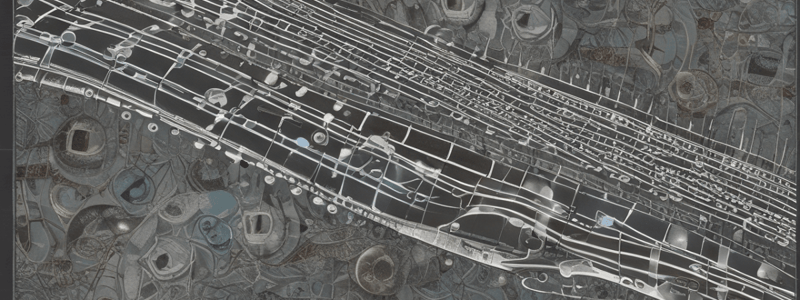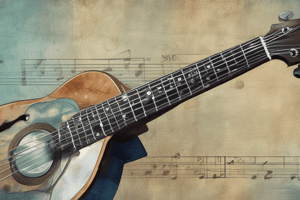Podcast
Questions and Answers
What is the origin of the name 'pentatonic scale'?
What is the origin of the name 'pentatonic scale'?
- From the Latin words 'pen' meaning five and 'ton' meaning tone
- From the Italian words 'penta' meaning five and 'tono' meaning tone
- From the French words 'pente' meaning five and 'tonique' meaning tone
- From the Greek words 'penta' meaning five and 'tonic' meaning tone (correct)
Which notes are used to form the major pentatonic scale?
Which notes are used to form the major pentatonic scale?
- First, second, fourth, fifth, and seventh notes of a major scale
- First, third, fourth, fifth, and sixth notes of a major scale
- First, second, third, fifth, and sixth notes of a major scale (correct)
- First, second, third, fourth, and fifth notes of a major scale
What is the main difference between the major and minor pentatonic scales?
What is the main difference between the major and minor pentatonic scales?
- Key used to form the scale
- Number of notes used
- Notes selected from the major or minor scale (correct)
- Intervals used to form the scale
Why is the pentatonic scale widely used in music?
Why is the pentatonic scale widely used in music?
What is the 'blue note' in the blues scale?
What is the 'blue note' in the blues scale?
What is the relation between the blues scale and the minor pentatonic scale?
What is the relation between the blues scale and the minor pentatonic scale?
In which genres of music is the blues scale heavily used?
In which genres of music is the blues scale heavily used?
What is the advantage of the pentatonic scale?
What is the advantage of the pentatonic scale?
What is the blues scale formed by adding to the standard minor pentatonic scale?
What is the blues scale formed by adding to the standard minor pentatonic scale?
What is the purpose of learning the patterns and fingerings for the pentatonic and blues scales?
What is the purpose of learning the patterns and fingerings for the pentatonic and blues scales?
What technique is commonly used in blues and rock solos?
What technique is commonly used in blues and rock solos?
What is the result of combining major and minor pentatonic scales?
What is the result of combining major and minor pentatonic scales?
What is the benefit of exploring different positions of the pentatonic and blues scales?
What is the benefit of exploring different positions of the pentatonic and blues scales?
What is essential to understanding scales and is widely used in various musical genres?
What is essential to understanding scales and is widely used in various musical genres?
What is the result of practicing patterns, exploring different positions, and incorporating techniques such as bending and sliding?
What is the result of practicing patterns, exploring different positions, and incorporating techniques such as bending and sliding?
What is the significance of understanding modes in music?
What is the significance of understanding modes in music?
What is the definition of modes in music?
What is the definition of modes in music?
What is the unique characteristic of each mode?
What is the unique characteristic of each mode?
What is the formula for the Dorian mode?
What is the formula for the Dorian mode?
What is the characteristic of the Phrygian mode?
What is the characteristic of the Phrygian mode?
What is the formula for the Lydian mode?
What is the formula for the Lydian mode?
Which mode is often associated with blues, rock, and funk music?
Which mode is often associated with blues, rock, and funk music?
What is the Aeolian mode also referred to as?
What is the Aeolian mode also referred to as?
What is the characteristic of the Locrian mode?
What is the characteristic of the Locrian mode?
What is modal mixture in harmonization?
What is modal mixture in harmonization?
Why is modal mixture used in composition?
Why is modal mixture used in composition?
What is necessary to effectively utilize modal mixture?
What is necessary to effectively utilize modal mixture?
What is the benefit of using modes in composition?
What is the benefit of using modes in composition?
What is the main characteristic of the Dorian mode?
What is the main characteristic of the Dorian mode?
What is the primary use of the Phrygian mode in music?
What is the primary use of the Phrygian mode in music?
Which mode is often associated with a bright and dreamy quality?
Which mode is often associated with a bright and dreamy quality?
What is the primary characteristic of the Mixolydian mode?
What is the primary characteristic of the Mixolydian mode?
Which mode is less commonly used due to its unstable nature?
Which mode is less commonly used due to its unstable nature?
What is the result of modal interchange in music composition?
What is the result of modal interchange in music composition?
What is the primary benefit of understanding modes in music?
What is the primary benefit of understanding modes in music?
What is the formula for the Ionian mode?
What is the formula for the Ionian mode?
What is the main characteristic of the Lydian mode?
What is the main characteristic of the Lydian mode?
Which mode is often used in jazz, rock, and pop music?
Which mode is often used in jazz, rock, and pop music?
Which mode allows us to borrow a ii chord?
Which mode allows us to borrow a ii chord?
What is the result of borrowing a iii chord from E Phrygian in the key of C major?
What is the result of borrowing a iii chord from E Phrygian in the key of C major?
What chord can be borrowed from the Aeolian mode?
What chord can be borrowed from the Aeolian mode?
What is the VII chord borrowed from the Locrian mode in the key of C major?
What is the VII chord borrowed from the Locrian mode in the key of C major?
What is temporary borrowing in modal mixture?
What is temporary borrowing in modal mixture?
What is the result of modulating to a related key in modal mixture?
What is the result of modulating to a related key in modal mixture?
What is the effect of introducing a borrowed chord in a composition?
What is the effect of introducing a borrowed chord in a composition?
What is the primary goal of using modal mixture in harmonization?
What is the primary goal of using modal mixture in harmonization?
Study Notes
Pentatonic and Blues Scales
- Pentatonic scale is a five-note scale widely used in music, especially in rock, blues, and jazz
- Originates from Greek words "penta" meaning five and "tonic" meaning tone
- Can be derived from major or minor scales, leading to Major Pentatonic Scale and Minor Pentatonic Scale
- Lacks half-step intervals, making it easy to play and suitable for improvisation and melody creation
- Fits well over major and minor chords, providing a neutral and melodic sound
Major Pentatonic Scale
- Formed by taking the first, second, third, fifth, and sixth notes of a major scale
- Example: C major pentatonic scale is C, D, E, G, and A
Minor Pentatonic Scale
- Formed by selecting the first, third, fourth, fifth, and seventh notes of a minor scale
- Example: A minor pentatonic scale is A, C, D, E, and G
Blues Scale
- Extension of the minor pentatonic scale, adding a "blue note" (flattened fifth or sharpened fourth)
- Adds tension and character to the scale
- Used in blues, jazz, rock, and other genres
- Example: A blues scale is A, C, D, Eb, E, and G
Applications and Improvisation
- Understanding pentatonic and blues scales opens up possibilities for improvisation and soloing
- Tips for incorporating these scales:
- Learn patterns and fingerings in various keys
- Practice bending and sliding techniques
- Combine major and minor pentatonic scales
- Explore different positions on the fretboard
- Listen to recordings of experienced guitarists
Modes in Music
- Modes are scales derived from the major scale
- Each mode has a unique set of intervals, creating a distinct musical mood or flavor
- Used in various genres, including classical, jazz, rock, and pop
Modes of the Major Scale
- Ionian Mode: major scale itself, bright and uplifting sound
- Dorian Mode: minor mode with a bright and uplifting quality
- Phrygian Mode: minor mode with a Spanish or exotic feel
- Lydian Mode: major mode with a bright and dreamy quality
- Mixolydian Mode: major mode with a bluesy, rock, and folk feel
- Aeolian Mode: natural minor scale, commonly used in classical, jazz, and pop music
- Locrian Mode: minor mode with a dark and dissonant sound
Using Modes in Composition and Improvisation
- Modes offer endless possibilities for composition and improvisation
- Experimentation with modes broadens musical vocabulary and creates captivating compositions
- Modal interchange and modulation add complexity and color to compositions
Modal Mixture in Harmonization
- Involves borrowing chords or harmonic elements from a different mode or key
- Creates an interesting and unexpected tonal color within a composition
- Commonly used in classical, jazz, pop, and beyond
- Examples of borrowed chords:
- ii chord from Dorian mode
- iii chord from Phrygian mode
- IV chord from Mixolydian mode
- vi chord from Aeolian mode
- VII chord from Locrian mode
- Techniques for applying modal mixture:
- Temporary borrowing
- Parallel modulation
- Modulating to a related key
Studying That Suits You
Use AI to generate personalized quizzes and flashcards to suit your learning preferences.
Description
Learn about the characteristics and applications of pentatonic and blues scales in music, including their relation to broader scale concepts.




